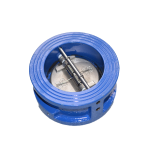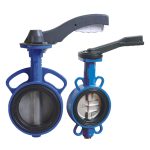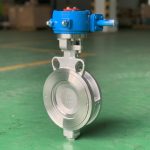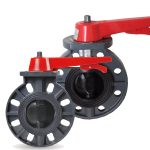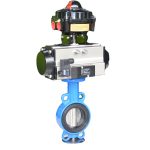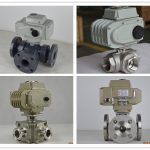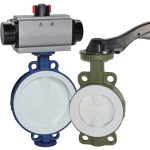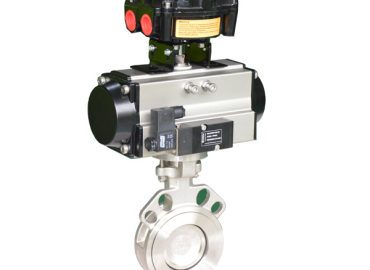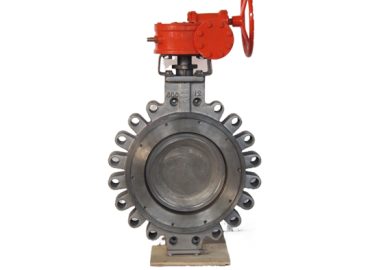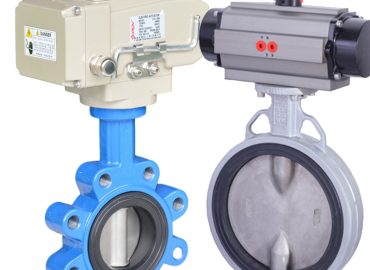In the intricate world of fluid control systems, valves play a pivotal role in regulating flow and pressure. Among the numerous types of valves that engineers and technicians deal with, the lug body butterfly valve stands out due to its unique design and functionality. This type of valve, known for its durability and cost-effectiveness, is used across various industries from water treatment to oil and gas. But what exactly is a lug body butterfly valve, and what makes it so essential? Let’s delve deeper into the basic function of this versatile device and understand its importance in fluid control systems.
Introduction
A lug body butterfly valve is a specialized type of valve designed for controlling the flow of liquids, gases, and slurries in a pipe or other conduit. Its basic function lies in its ability to either fully allow, restrict, or completely stop the flow of a fluid. This is achieved through a disc (the ‘butterfly’) that is positioned in the middle of the pipe. The disc is attached to a rod which is connected to an actuator on the outside of the valve. When the actuator is turned, it rotates the disc either parallel or perpendicular to the flow. In the parallel position, fluid can pass freely through the valve; when it’s turned perpendicular, the disc blocks the pipe, halting the flow. One of the distinguishing features of a lug body butterfly valve is its ‘lug’ design. Unlike other types of butterfly valves, the lug body has metal inserts, or ‘lugs’, spaced around the valve body. These lugs allow the valve to be installed into a system using two sets of bolts and no nuts, which means it can be installed in either direction and can be removed from the system without disrupting the piping around it. This makes lug body butterfly valves extremely versatile and useful in a wide range of applications.
Brief introduction to the world of valves and their importance in various industries.
Valves are an essential part of many industries, serving as the control points in a wide range of systems. In essence, they are devices that regulate, direct, or control the flow of fluids such as gases, liquids, fluidized solids, or slurries, by opening, closing, or partially obstructing various passageways. From the petrochemical industry to food and beverage production, from water treatment facilities to the pharmaceutical sector, valves play a crucial role. They allow these industries to operate safely and efficiently, controlling process flows with precision and reliability. Whether it’s maintaining pressure, managing flow rate, or isolating and securing systems, valves are indispensable tools. Their importance cannot be overstated, as they ensure that our daily operations, whether industrial or domestic, run smoothly and safely.
Introduction to the lug body butterfly valve.
The lug body butterfly valve, a specific type of electric butterfly valve, is a critical component in many industrial applications. Characterized by its unique ‘lug’ design, this valve has metal inserts or ‘lugs’ around the body which allow it to be installed using two sets of bolts and no nuts. This means it can be fitted into any direction and removed without disrupting the surrounding piping. The valve operates through a disc positioned within the pipe which rotates to control the flow of fluid. When the disc aligns with the flow, the fluid passes freely; when it’s turned perpendicular, the flow halts. With its compact size, ease of operation, and cost-effectiveness, the lug body butterfly valve is a popular choice for systems where flow needs to be regulated efficiently and effectively.
Lug butterfly valee nut bolt
The Lug Nut Bolt is a key component in the complex ecosystem of valve manufacturing. It plays a central role in securing lug butterfly valves, which are recognized for their efficiency, versatility, and durability across a range of industries.
The lug butterfly valve features unique ‘lugs’ around its circumference that are threaded to accommodate bolts. The nut bolt is the essential connection element that affixes the valve securely between two flanges within a piping system, ensuring a firm seal and reliable operation.
The dimensions of the bolt vary depending on the size of the valve. For instance, a 2″ lug butterfly valve requires a 5/8″ bolt with 11 threads per inch and a length of 1-1/2″. On the other hand, a 4″ valve requires a 5/8″ bolt with 11 threads per inch and a length of 1-3/4″.

What is a Lug Body Butterfly Valve?
A lug body butterfly valve is a specific type of quarter-turn valve designed to regulate the flow of fluid in a conduit. This valve’s unique design features a disc, known as the ‘butterfly’, that is positioned in the middle of the pipe and connected to an actuator. The actuator, when turned, rotates the disc either parallel or perpendicular to the flow, controlling the fluid passage. The term ‘lug body’ refers to the presence of metal inserts, or ‘lugs’, around the valve body. These lugs allow the valve to be bolted between two flanges in a piping system using a set of bolts. This design enables the valve to be installed or removed without the need to disturb the surrounding piping system. Furthermore, the lugs provide strength and stability to the valve, allowing it to handle higher pressure conditions. With their compact design, easy operation, and ability to handle a variety of fluids, lug body butterfly valves are widely used in numerous industries, including water treatment, oil and gas, and chemical processing.
Definition of a lug body butterfly valve.
A lug body butterfly valve is a distinct type of valve widely used in various industries for regulating fluid flow. The defining feature of this valve is its ‘lug’ design, where metal inserts or ‘lugs’ are situated around the valve’s body. These lugs allow the valve to be installed into a system using two sets of bolts and no nuts, enabling it to be fitted in either direction and removed without disturbing the surrounding piping. The valve operates by rotating a disc, or the ‘butterfly’, within the pipe. When the disc is aligned with the flow, fluid can pass freely; when turned perpendicular, the flow is stopped. This mechanism makes the lug body butterfly valve an efficient tool for controlling the flow of fluids in a wide range of applications.
Explanation of its components and their functions.
A lug body butterfly valve comprises several key components, each serving a specific function. The primary component is the disc, also known as the ‘butterfly’, which is centrally positioned within the pipe and connected to an actuator through a rod. The actuator is responsible for rotating the disc to control the flow of fluid through the valve. When the disc is parallel to the flow direction, the valve is open, allowing fluids to pass freely. Conversely, when the disc is turned perpendicular to the flow, the valve is closed, stopping the fluid flow. The ‘lug’ part of this valve refers to the metal inserts or ‘lugs’ around the valve body. These lugs allow the valve to be bolted between two flanges in a piping system. This design allows the valve to be installed or removed without affecting the surrounding piping system. Moreover, these lugs provide added strength and stability to the valve, enabling it to handle higher pressure conditions effectively.
Different types of butterfly valves and where lug body fits in.
Butterfly valves come in several types, each serving a specific purpose based on their design and functionality. The three primary types are the concentric, double offset, and triple offset butterfly valves. Concentric butterfly valves, also known as resilient seated butterfly valves, feature a rubber lining and are commonly used in low pressure and temperature applications due to their cost-effectiveness and simplicity. Double offset butterfly valves, or high-performance butterfly valves, have an off-center disc and stem design that reduces wear and tear, making them suitable for higher pressure and temperature applications. Triple offset butterfly valves, also known as metal-seated butterfly valves, have a disc and stem that are both doubly off-center and angled, providing even better sealing capabilities and making them suitable for extreme conditions.
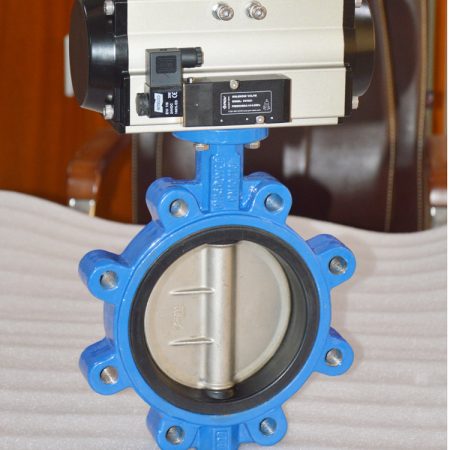
The lug body butterfly valve falls into a sub-category based on its unique mounting system. It features ‘lugs’ or metal inserts around its body that allow it to be mounted between two flanges using bolts, without the need for nuts. This design enables easy installation and removal of the valve without disturbing the surrounding piping, making it highly versatile and suitable for a wide range of applications across various industries.
How Does a Lug Body Butterfly Valve Work?
A lug body butterfly valve operates through a simple yet effective mechanism to regulate the flow of fluids in a conduit. At the heart of this valve is a disc, often referred to as the ‘butterfly’, which is centrally mounted within the pipe and connected to an actuator. This actuator could be a manual lever or an automated system. When the actuator is turned, it rotates the disc either parallel or perpendicular to the flow of fluid. In the fully open position, the disc aligns with the direction of the fluid flow, offering minimal resistance and allowing the fluid to pass freely. Conversely, when the disc is rotated to a position perpendicular to the flow, it blocks the passage, halting the flow of fluid completely.
The defining feature of a lug body butterfly valve, distinguishing it from other types of butterfly valves, are the ‘lugs’ or metal inserts around its body. These lugs allow the valve to be bolted between two flanges in a piping system using a series of bolts. This unique design allows the valve to be installed or removed without the need to disconnect or disrupt the rest of the piping system. It also enables the valve to handle bidirectional flow, increasing its versatility. Thus, the combination of a simple, efficient flow control mechanism and a flexible, convenient mounting system makes the lug body butterfly valve a popular choice in many industries, from water treatment to oil and gas, and chemical processing.
Detailed explanation of the working mechanism of a lug body butterfly valve.
A lug body butterfly valve operates through an intricate mechanism that effectively manages the flow of fluids. The core component is a disc, often known as the ‘butterfly’, which is centrally positioned in the pipeline and linked to an actuator via a stem. This actuator can be manually operated or automated. When the actuator turns, it rotates the disc either parallel or perpendicular to the fluid flow. When the disc is parallel to the flow, the valve is fully open, providing minimal resistance and allowing the fluid to flow freely. Conversely, when the disc is perpendicular, it obstructs the passage, halting fluid flow completely.
The distinguishing feature of a lug body butterfly valve is its ‘lugs’ or metal inserts around the valve body. These lugs allow the valve to be sandwiched between two pipe flanges using bolts, facilitating easy installation and removal without the need to disrupt the surrounding piping system. Furthermore, this design allows the lug body butterfly valve to support bidirectional flow, increasing its versatility. The valve’s disc position can be adjusted to intermediate angles for modulating flow, making it an efficient tool for both isolating and regulating fluid flow. This combination of simple operation, efficient flow control, and versatile mounting makes the lug body butterfly valve a popular choice across various industries.
Use of diagrams or animations to illustrate the process.
The use of diagrams or animations can be incredibly helpful in illustrating the complex processes and mechanisms of a lug body butterfly valve. Visual aids can simplify the understanding of how the valve operates, illustrating the rotation of the ‘butterfly’ disc, the role of the actuator, and the function of the lugs. For instance, an animation could show the fluid flow when the disc is parallel and perpendicular to the flow direction, demonstrating how the valve controls fluid passage. It could also depict the installation process, showing how the valve is sandwiched between two pipe flanges using bolts through the lugs. This graphical representation can enhance comprehension, particularly for those unfamiliar with such technical equipment, making it a valuable tool in both educational and professional settings. Whether for training purposes or product presentations, diagrams and animations can significantly contribute to a clearer understanding of the workings of a lug body butterfly valve.
Explanation of what happens when the valve is opened and closed.
The operation of a lug body butterfly valve involves two primary positions: open and closed. When the valve is opened, the actuator rotates the disc (the ‘butterfly’) until it aligns parallel with the fluid flow. In this position, the disc presents minimal obstruction to the fluid, allowing it to pass through the pipeline freely. This is the maximum flow state of the valve.
On the other hand, when the valve is closed, the actuator rotates the disc so that it’s perpendicular to the fluid flow. In this position, the disc completely obstructs the pipeline, halting the flow of fluid entirely. This is the zero flow state of the valve.
It’s important to note that the disc can also be positioned at various intermediate angles between these two extreme positions to regulate or modulate the fluid flow, providing partial opening or closing of the valve. This flexibility in controlling the flow rate makes the lug body butterfly valve an efficient and versatile tool in many industrial applications.

Applications of Lug Body Butterfly Valves
Lug body butterfly valves find extensive application across a wide range of industries due to their durability, versatility, and efficiency in controlling fluid flow. These valves are commonly used in water and wastewater treatment plants due to their ability to handle large volumes of water and other fluids effectively. They’re also widely employed in the oil and gas industry for their capacity to withstand high-pressure conditions and perform reliably under harsh environments.
In the chemical industry, lug body butterfly valves are used to control the flow of various corrosive and non-corrosive fluids. Their robust construction and the availability of different lining materials make them suitable for managing a wide range of chemicals. Additionally, they find application in HVAC systems (Heating, Ventilation, and Air Conditioning) for regulating airflow, where their compact design and efficient operation are particularly beneficial.
In food and beverage industries, these valves are often chosen for their easy maintenance and cleanability, crucial factors in maintaining hygiene standards. Lug body butterfly valves are also utilized in fire protection systems, given their quick and reliable open-close operation. Furthermore, they are used in power generation facilities, pulp and paper mills, and various other industrial processes that require effective flow control solutions. The ability to support bidirectional flow, coupled with the convenience of installation and removal without disrupting the surrounding piping system, makes lug body butterfly valves an integral component in many industrial applications.
Overview of the industries or systems that commonly use lug body butterfly valves.
Lug body butterfly valves are commonly used across a diverse range of industries and systems due to their robust design, efficient operation, and versatility. In the water and wastewater treatment industry, they are preferred for their ability to effectively manage large volumes of fluid. The oil and gas industry also frequently utilizes these valves due to their durability under high-pressure conditions and harsh environments.
In the chemical industry, lug body butterfly valves are favored for controlling the flow of various corrosive and non-corrosive fluids, thanks to their sturdy construction and the availability of different lining materials. They are also widely used in HVAC (Heating, Ventilation, and Air Conditioning) systems for regulating airflow, benefiting from their compact design and efficient operation.
The food and beverage industry often opts for these valves because of their easy maintenance and cleanability, crucial for maintaining hygiene standards. Additionally, they are utilized in fire protection systems for their quick and reliable open-close operation. Power generation facilities, pulp and paper mills, and various other industrial processes that require effective flow control solutions also commonly use lug body butterfly valves. Their ability to handle bidirectional flow and be installed or removed without disrupting the surrounding piping system makes them an essential component in many industrial applications.
Explanation of why these industries choose lug body butterfly valves over other types.
Several reasons make lug body butterfly valves the preferred choice over other types of valves in many industries. One of the primary reasons is their ability to handle bidirectional flow, which provides greater versatility in system design and operation. This feature is particularly valuable in systems where flow direction may need to change, such as in certain chemical processing or water treatment applications.
Another significant advantage is their compact design and lightweight nature compared to other valve types like gate or globe valves. This makes them easier to install and maintain, particularly in tight spaces or where weight is a concern.
The unique ‘lug’ design allows these valves to be installed or removed without the need to disrupt the surrounding piping system – a convenience that can save time and resources during maintenance or system modifications.
Also, lug body butterfly valves can provide reliable sealing and efficient flow control, even under high-pressure conditions. This makes them suitable for use in industries like oil and gas, where operating conditions can be severe.
Finally, the availability of different lining materials for the disc and seals allows these valves to be tailored to handle a wide range of fluids, including corrosive chemicals, making them a versatile solution for various industrial processes.
Case studies or examples of real-world applications.
Real-world applications of lug body butterfly valves are abundant across various industries. For instance, in a water treatment plant, these valves are often used to control the flow of water through different stages of the treatment process. Their ability to handle large volumes of fluid and operate reliably under varying pressure conditions makes them an ideal choice for such applications.
In another example, a chemical manufacturing company might use lug body butterfly valves to manage the flow of corrosive chemicals through their processing lines. The availability of different lining materials allows these valves to handle a wide range of chemicals without degradation, providing a reliable and durable solution for flow control.
Within the oil and gas industry, these valves are often found in pipeline systems for transporting crude oil or natural gas. Their robust design and ability to withstand high-pressure conditions make them well-suited for such demanding applications.
In HVAC systems, lug body butterfly valves are used to regulate airflow, contributing to the efficient operation of heating and cooling systems in buildings. The compact design of these valves makes them a practical choice for such applications where space can be limited.
These examples highlight the versatility and efficiency of lug body butterfly valves in managing fluid flow across a wide range of real-world applications.
Advantages and Disadvantages of Lug Body Butterfly Valves
Lug body butterfly valves come with a host of advantages that make them a preferred choice in many industries. One of their key benefits is the ability to handle bidirectional flow, offering flexibility in system design and operation. Their compact design and lightweight nature compared to other valve types like gate or globe valves make them easier to install and maintain, especially in tight spaces or where weight is a concern.
The unique ‘lug’ design allows these valves to be installed or removed without needing to disrupt the entire piping system, saving significant time and resources during maintenance or system modifications. In terms of performance, lug body butterfly valves provide reliable sealing and efficient flow control, even under high-pressure conditions, making them suitable for severe operating conditions such as those found in the oil and gas industry.

Lastly, they can be customized with different lining materials for the disc and seals, enabling them to handle a wide range of fluids, including corrosive chemicals, thus enhancing their versatility.
However, lug body butterfly valves also have certain drawbacks. While they are excellent for on/off and throttling services, they may not be as precise in controlling flow rate as some other types of valves, such as needle valves. Also, while they can handle a wide variety of fluids, they might not be suitable for very thick or abrasive fluids or those containing solid particles, as these can cause wear and tear on the disc and seals. Additionally, while the lug design offers many benefits, it may also require more bolts for installation compared to wafer-style butterfly valves, potentially increasing the time and cost of installation. Despite these disadvantages, the numerous benefits of lug body butterfly valves often outweigh their drawbacks, making them an effective solution for many fluid control applications.
Discussion on the advantages of using lug body butterfly valves.
Lug valve offer several advantages that make them a popular choice across various industries. One of the primary benefits of these valves is their ability to handle bidirectional flow, offering greater flexibility in system design and operation. This feature allows for the potential change of flow direction, which can be particularly useful in certain chemical processing or water treatment applications.
Their compact design and lightweight nature compared to other valve types, such as gate or globe valves, is another significant advantage. These characteristics make lug body butterfly valves easier to install and maintain, especially in tight spaces or where weight considerations are crucial.
The unique ‘lug’ design of these valves allows them to be installed or removed without needing to disrupt the surrounding piping system. This means maintenance or system modifications can be executed more efficiently, saving valuable time and resources.
Furthermore, lug body butterfly valves can provide reliable sealing and efficient flow control under high-pressure conditions. This makes them an excellent option for demanding industries like oil and gas.
Lastly, the availability of different lining materials for the disc and seals allows these valves to handle a wide range of fluids, including corrosive chemicals. This adaptability enhances their versatility and broadens their applicability across various industrial processes.
Honest talk about the disadvantages or limitations of these valves.
While lug type butterfly valve offer numerous advantages, they do come with certain limitations. For instance, while they are excellent for on/off and throttling services, they may not provide the same level of precision in controlling flow rate as other types of valves, such as needle valves. This could potentially limit their effectiveness in applications where precise control over fluid flow is required.
Additionally, although they can handle a wide variety of fluids due to the availability of different lining materials for the disc and seals, they might not be suitable for very viscous or abrasive fluids, or those containing solid particles. Such substances can cause wear and tear on the disc and seals, leading to reduced performance over time.
Another potential limitation is that the lug design, while offering many benefits, also requires more bolts for installation compared to wafer-style butterfly valves. This could increase the time and cost of installation, which might not be ideal for certain applications.
Lastly, like all mechanical components, lug body butterfly valves are subject to eventual wear and tear, and will require maintenance and possible replacements over time. Despite these limitations, however, lug body butterfly valves remain a versatile and reliable solution for many fluid control applications.
Comparison with other types of valves.
When compared with other types of valves, lugged butterfly valve offer several unique advantages. For instance, compared to gate or globe valves, lug body butterfly valves have a more compact design and are lighter in weight. This makes them easier to install, especially in tight spaces or where weight considerations are crucial.
Compared to ball valves, lug body butterfly valves can be more cost-effective, particularly for large diameter pipe applications. They also generally have a shorter face-to-face dimension, which can make them a preferred choice in space-constrained installations.
Unlike check valves that allow flow in one direction only, lug body butterfly valves can handle bidirectional flow, offering greater flexibility in system design.
When compared to wafer-style butterfly valves, lug body valves have the advantage of being mountable on flanges, allowing them to be installed or removed without disturbing the surrounding piping system. This can save significant time and resources during maintenance or system modifications.
However, it’s also important to note that lug body butterfly valves might not provide the same level of precision in controlling flow rate as needle valves or diaphragm valves. Also, they might not be suitable for handling very viscous or abrasive fluids, or those containing solid particles, unlike some types of rotary or slide gate valves.
The choice of valve type ultimately depends on the specific requirements of the application, including factors like fluid type, pressure and temperature conditions, required flow control precision, installation constraints, and budget considerations.
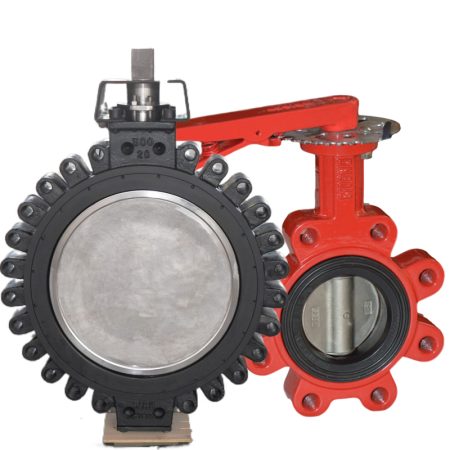
Choosing the Right Lug Body Butterfly Valve
Choosing the right lug style butterfly valve requires careful consideration of several factors. The first and foremost is the nature of the fluid that the valve will handle. Different lining materials for the disc and seals are available to handle a wide range of fluids, including corrosive chemicals. Therefore, understanding the chemical composition, temperature, and pressure of the fluid is crucial in selecting the appropriate materials to ensure the valve’s longevity and performance.
Flow direction is another important consideration. Lug body butterfly valves are capable of handling bidirectional flow, making them a versatile choice for systems where flow direction may need to change. However, if the system only requires unidirectional flow, other types of valves might also be suitable.
The physical constraints of the installation site should also be considered. Thanks to their compact design and lightweight nature, lug body butterfly valves can be an excellent choice for tight spaces or where weight is a concern. But it’s also worth noting that the lug design may require more bolts for installation compared to wafer-style butterfly valves, which could potentially increase the time and cost of installation.
Maintenance requirements are another key factor. The unique ‘lug’ design allows these valves to be installed or removed without disrupting the surrounding piping system, which can make maintenance or system modifications more efficient.
Finally, budget considerations will inevitably play a role in the decision-making process. While lug body butterfly valves can be more cost-effective than some other types of valves, especially for large diameter pipe applications, the total cost of ownership should be considered, including initial purchase cost, installation costs, and ongoing maintenance expenses.
By carefully considering all these factors, you can select the lug body butterfly valve that best meets your specific application needs and provides reliable, efficient performance over its lifetime.
Factors to consider when choosing a lug body butterfly valve.
When choosing a lug butterfly valve, several factors need to be taken into account. The type of fluid that the valve will handle is one of the most important considerations. Understanding the chemical composition, temperature, and pressure of the fluid is crucial in selecting a valve with the appropriate lining materials for the disc and seals. This ensures that the valve can handle the specific fluid without degradation, providing reliable and long-lasting performance.
Another key factor is the direction of flow. Lug body butterfly valves are capable of handling bidirectional flow, making them a versatile choice for systems where flow direction may change. However, if the system only requires unidirectional flow, other types of valves might also be suitable.
Physical constraints of the installation site, such as available space and weight limitations, should also be considered. Lug body butterfly valves are compact and lightweight, making them an excellent choice for tight spaces or where weight is a concern. However, keep in mind that the lug design may require more bolts for installation compared to wafer-style butterfly valves, which could potentially increase the time and cost of installation.
Maintenance requirements and the total cost of ownership are other essential factors. While lug body butterfly valves can often be more cost-effective than some other types of valves, especially for large diameter pipe applications, the initial purchase cost, installation costs, and ongoing maintenance expenses should all be considered when making your decision. By considering these factors, you can choose the lug body butterfly valve that best meets your specific needs.
Tips on how to ensure you get the right valve for your needs.
To ensure you get the right valve for your needs, it’s crucial to conduct a thorough assessment of your system requirements and operating conditions. Start by identifying the type of fluid the valve will handle. Understanding its chemical composition, temperature, and pressure will help you choose a valve with appropriate lining materials for the disc and seals.
Consider the flow direction required in your system. If you need bidirectional flow, a lug body butterfly valve is an excellent choice. However, if your system requires unidirectional flow, other types of valves might be more suitable.
Take into account the physical constraints of your installation site. Evaluate the available space and weight limitations to determine if a compact and lightweight lug body butterfly valve would be ideal. Remember, while lug body butterfly valves are easy to install and maintain, they may require more bolts for installation than wafer-style butterfly valves, potentially affecting installation time and costs.
Finally, consider the total cost of ownership, not just the initial purchase cost. This includes installation costs, ongoing maintenance expenses, and potential replacement costs over the valve’s lifetime. By carefully evaluating these factors, you can select the most suitable valve that provides reliable performance and value for money.

Importance of quality and choosing reliable manufacturers.
The importance of quality and choosing reliable manufacturers in the valve industry cannot be overstated. High-quality valves, produced by reputable manufacturers, ensure efficient, safe, and reliable operation of your industrial systems. They are designed to withstand the rigors of harsh operating conditions, resist corrosion, and provide a tight seal to prevent leaks. This is crucial for maintaining the integrity of your systems, preventing costly downtime, and ensuring the safety of your operations.
Reliable manufacturers adhere to strict quality control standards throughout their production process, from the selection of raw materials to the final product testing. They often hold certifications from recognized industry bodies, which provides an assurance of their commitment to quality.
Choosing a reliable manufacturer also means you’ll benefit from their expertise and customer support. They can provide valuable advice on the correct valve type for your specific application, offer installation guidance, and deliver prompt after-sales service.
In contrast, opting for lower-quality valves may result in frequent failures, increased maintenance costs, and potential safety risks. Therefore, investing in high-quality valves from reliable manufacturers is not just a matter of getting what you pay for, but it’s also about ensuring operational efficiency, reliability, and peace of mind.
Conclusion
In conclusion, the basic function of a lug body pneumatic butterfly valve is to control and regulate the flow of fluids in industrial systems. These valves are an integral part of many industries, offering unique advantages over other types of valves. They are designed with a disc that rotates to open, close or modulate the flow of the fluid, and their ‘lug’ design allows them to be mounted between flanges, providing flexibility during installation and maintenance.
Their compact design and lightweight nature make them ideal for installations where space and weight are critical considerations. Moreover, they are suited to handle bidirectional flow, offering greater versatility in system design. These features, coupled with their potential cost-effectiveness, especially for large diameter pipe applications, make lug body butterfly valves a popular choice for a wide range of industrial applications.
However, it’s crucial to remember that choosing the right lug body butterfly valve requires careful consideration of several factors including the type of fluid, flow direction, physical constraints of the installation site, maintenance requirements, and budget considerations. By thoroughly understanding these factors, you can ensure the selection of the right valve that meets your specific requirements and provides reliable, efficient performance.
Lastly, the importance of opting for high-quality valves from reliable manufacturers should not be overlooked. High-quality valves ensure efficient, safe, and reliable operation, while reliable manufacturers provide valuable advice, installation guidance, and prompt after-sales service. Therefore, investing in high-quality lug body butterfly valves from reputable manufacturers is essential for ensuring operational efficiency, reliability, and peace of mind.
Understanding the basic function and benefits of lug body butterfly valves is the first step towards making an informed decision for your industrial valve needs. With the right valve, you can achieve efficient control and regulation of fluid flow, ensuring optimal performance of your systems.



